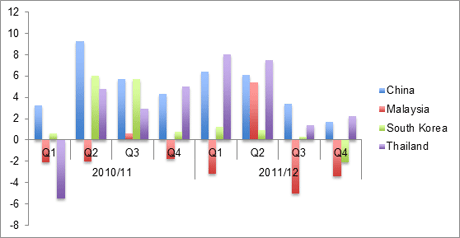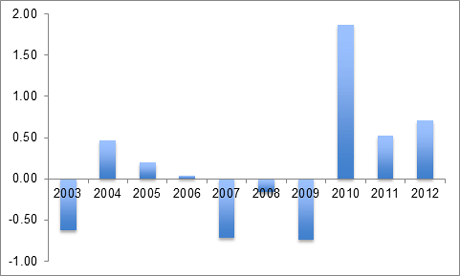Should you buy the Tesco recovery story?
For the first time in 20 years, Tesco's UK profits have fallen. But the company says it has a recovery plan. Phil Oakley examines whether it's enough to get Tesco out of the mire - and whether you should buy its shares.
Investors in Tesco breathed a huge sigh of relief this morning.
Trading has not got any worse, and there is a clear recovery plan for the UK business.
Unsurprisingly, the shares initially reacted well to this news. Or at least, they haven't fallen that much.
MoneyWeek
Subscribe to MoneyWeek today and get your first six magazine issues absolutely FREE

Sign up to Money Morning
Don't miss the latest investment and personal finances news, market analysis, plus money-saving tips with our free twice-daily newsletter
Don't miss the latest investment and personal finances news, market analysis, plus money-saving tips with our free twice-daily newsletter
But is Tesco out of the woods? Far from it. Let's have a look at what's going on.
Is the UK recovery plan good enough?
UK trading isn't getting any worse for Tesco. The company has confirmed it is happy with analysts' forecasts for 2012/13. But how does it plan to turn the UK business around?
On the face of it, a lot of what Tesco has announced looks very sensible. It is cutting its store opening plans in the UK by more than a third, and is focusing on smaller, less asset-intensive formats such as Tesco Express.
£400m will be spent refreshing around a quarter of its UK stores. This is long overdue, as many of its stores have become scruffy and tired in recent years. But £400m may not be enough in the longer run.
Meanwhile, £500m will be invested in better pricing. In the past, Tesco has been successful because it was smarter and more innovative with its pricing than its competitors. That is no longer true.
Sainsbury's is promising to match prices on brands whilst Asda is promising to be 10% cheaper on comparable shopping lists. Tesco admits that it needs to restore customer trust in its pricing. The trouble is, once customers are lost, it is hard to get them back.
That leads us to quality. Too many customers are no longer keen on Tesco's food quality. Tesco is investing in staff and its fresh food offers, but the competition here is tough too.
Then there's the online business. A new website and £150m of investment makes sense, given that more of us are buying goods over the internet. But can Tesco compete with Amazon?
More to the point, how is Tesco is going to make decent returns from the 30% of its stores that are over 60,000 square feet? These hypermarkets, which were built to sell non-food items, could prove a drag on returns for many years to come.
In short, while it's good news that Tesco is tackling its problems in the UK, it faces a lot of headwinds. Competition in food retail is savage, consumers have less money to spend, and some parts of the country are saturated with supermarkets.
A bolder strategy would have involved shutting stores that cannot hope to make good returns, but Tesco hasn't taken that step yet.
If Tesco can stop the rot, then its UK business will generate more cash. But profit margins are unlikely to go back above 6% for some time if ever.
Overseas growth is slowing and Tesco should abandon the US
Tesco bulls will point to the strength of its overseas business. But it's not clear that everything is rosy there either.
Profits in Asia rose 21.8% to £737m. This was a very good result, but growth rates are slowing.
The chart below shows the like-for-like sales performance of Tesco's Asian business for the last two years.
Tesco Asian like-for-like sales

Source: Tesco
As you can see, there has been a marked slowdown in sales growth. China sales, for example, were growing at over 6% at the start of 2011, but by the last quarter of the year that had slowed to just 1.7%.
High inflation and wage costs are hurting profits too. As a result, Tesco is slowing the pace of its investment in China.
Meanwhile, South Korean sales are declining on a like-for-like basis. In Europe, profits stagnated and actually fell by more than 7% during the second half of the year. The introduction of a sales tax charge in Hungary didn't help matters, whilst Ireland continues to be weak, offsetting a decent showing from Poland and Slovakia.
Over in the US, Tesco's Fresh & Easy business continued to make big losses. In 2011/12 it lost £153m. This is an improvement on the £186m lost in 2010/11, but still leaves the business a long way from break-even.
It's not surprising that Tesco has said that this business will need more time to hit break-even, but will it ever make decent profits to justify the amount of money spent? We don't think so. It's time for Tesco to admit that it has made an expensive mistake and get out of America.
Does the dividend signal a lack of confidence?
What about the dividend? With a big blue-chip like Tesco, dividend growth is an important consideration. The full-year dividend rose by 2.1%, but the final dividend barely grew at all. That's worth paying attention to.
Dividends can be great signalling mechanisms for investors. Tesco's dividend is more than twice covered by profits. So payouts have scope to grow. If the management was really confident of returning the UK business to growth, then a higher dividend should have been paid. Why wasn't it?
The answer may come down to cash flow. UK food retailers are not good at generating surplus cash flow. As Tesco's problems demonstrate, you have to keep ploughing back cash into stores to keep the customers happy.
It raises the question as to whether the profits of UK food retailers in general are overstated. Why do I say this? Because if they weren't, then the depreciation charge against sales would be sufficient to keep stores looking fresh.
If retailers have to spend more than depreciation to maintain assets and sales, then reported profits could be too high. Weak cash generation could be a warning of this.
Without selling properties, Tesco would not have had sufficient surplus cash to fully cover its dividend payments during the last year. It is cutting its capital investment, but it has to be careful to target it in the right areas. If profits do not recover and cash flow does not increase, dividends may not be able to grow.
During the last ten years, high levels of investment have resulted in Tesco only having sufficient cash flow to cover its dividends once in 2010. It's not just Tesco either: Sainsbury's has questions to answer here as well.
Tesco cash dividend cover before property disposals

To be fair, at 329p, a lot of Tesco's problems are probably reflected in the share price. It trades on 9.5 times 2012/13 forecast profits offering a yield of 4.7%. This is a similar valuation to Marks & Spencer.
However, while Tesco might be a cheap asset, if you really want to invest in the retail sector, you might sleep better owning M&S. As far as we're concerned, Tesco still has a lot of questions to answer before we'd be confident of its turnaround story.
Get the latest financial news, insights and expert analysis from our award-winning MoneyWeek team, to help you understand what really matters when it comes to your finances.
Phil spent 13 years as an investment analyst for both stockbroking and fund management companies.
After graduating with a MSc in International Banking, Economics & Finance from Liverpool Business School in 1996, Phil went to work for BWD Rensburg, a Liverpool based investment manager. In 2001, he joined ABN AMRO as a transport analyst. After a brief spell as a food retail analyst, he spent five years with ABN's very successful UK Smaller Companies team where he covered engineering, transport and support services stocks.
In 2007, Phil joined Halbis Capital Management as a European equities analyst. He began writing for MoneyWeek in 2010.
-
 The shape of yields to come
The shape of yields to comeCentral banks are likely to buy up short-term bonds to keep debt costs down for governments
-
 The sad decline of investment clubs – and what comes next
The sad decline of investment clubs – and what comes nextOpinion Financial regulation and rising costs are killing off investment clubs that once used to be an enjoyable hobby, says David Prosser